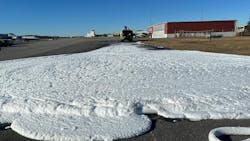Portland Jetport's Proactive Foam Transition Offers a Blueprint for Airport ARFF Operations Nationwide
Portland International Jetport (PWM) has become one of the early adopters of the Federal Aviation Administration's guidance to transition away from aqueous film-forming foam (AFFF) in favor of environmentally safer fluorine-free foam (F3).
The change was motivated by environmental and health concerns related to per- and polyfluoroalkyl substances (PFAS), which are known to persist in the environment and potentially cause harm to both ecosystems and humans.
The project began in earnest under the leadership of PWM's former fire chief, with the current Deputy Chief of the Portland Fire Department, John Cenate, taking the lead on implementation.
"We were buying a new truck, and we knew we didn’t want to put AFFF in it," Cenate said. "We wanted to be proactive."
Need and Scope for the Project
PWM's early decision to initiate the transition reflected both foresight and responsibility. According to Cenate, the department anticipated upcoming regulatory changes and saw the opportunity to act before mandates came into force.
"We didn’t want to wait until the last minute," he said. "The environmental impact and the carcinogenic risk of AFFF were too great."
The scope of the project included cleaning and transitioning legacy Oshkosh and Rosenbauer ARFF trucks, managing hazardous material disposal, securing compatible foam products, and retraining personnel for the operational differences between AFFF and F3. The team coordinated with suppliers, environmental contractors, and national foam manufacturers to ensure the transition met Department of Defense and FAA guidelines.
Execution began with the procurement of National Avio F3 Mil Spec 3% foam using the City of Portland's procurement policy. The team selected this product based on cost-effectiveness and compatibility with existing equipment.
Cenate described the decision-making process as rigorous. "There wasn’t a standout product that was clearly better than the rest, so we went with what gave us the best bang for our buck."
Truck modifications were minimal for newer equipment. The Rosenbauer ARFF required no changes, and the new Oshkosh Striker 1500 was delivered without any foam in its system, simplifying the transition. However, the legacy Oshkosh unit, which had previously contained AFFF, proved more challenging. Issues with flow rates and foam concentration percentages prompted the airport to lease a temporary ARFF vehicle to maintain FAA ARFF index compliance while undergoing service.
The cleaning process was more complex than expected. Despite industry guidance suggesting the transition could be completed in a matter of hours, PWM’s process often took two to three days per vehicle.
"We learned pretty quickly this wasn’t just a swap-and-go situation," Cenate said. "Everything had to be cleaned, dried, tested with surrogate foam, dried again, and then tested with actual F3 foam."
The department followed DOD guidance for rinsing vehicles but opted for an even more rigorous double-rinse process. Training also required innovation. A team was sent to South Carolina for hands-on training and later brought that knowledge back to PWM. Additional training with F3 training foam is scheduled as weather permits.
"The learning curve was steep," Cenate said. "With AFFF, you didn’t have to be a great operator to get a fire out. With F3, nozzle placement and foam blanket integrity are critical."
Lessons Learned and Funding Sources
Cenate noted that one of the biggest takeaways from the project was the realization that everything takes longer and costs more than expected.
"We underestimated the time and foam needed. One truckload of waste became two. One day became three," he said.
Disposal was also a major factor. PWM followed EPA and DOD disposal guidance and considered several methods, including deep well injection and solidification. Each method carried different risks and costs. Ultimately, PWM ensured full documentation and compliance to mitigate long-term liability.
The transition was made possible through a blend of local and federal resources. Foam procurement and disposal services were funded through the City of Portland’s budget, while compliance testing and certain training elements were aligned with FAA mandates. However, the airport did not rely on specific federal transition grants for this project, opting instead to allocate funds proactively.
Mutual aid considerations were also critical. PWM plans to coordinate with the nearby South Portland Fire Department, which is undergoing its own transition to F3.
"We’re planning joint training sessions this summer to ensure interagency compatibility," said Cenate.
Vision for the Future
PWM’s proactive foam transition serves as a model for other airports navigating the shift to fluorine-free solutions. "We were ahead of the curve," Cenate said. "This took almost two years to fully plan and execute."
The airport now views all legacy trucks that previously used AFFF as permanently contaminated. This cautious stance reflects an understanding of the potential for PFAS rebound or "bounce back" in systems, even after rigorous cleaning.
"Until the state provides clarity on what’s considered clean, we’re going to keep treating these systems as dirty," Cenate added.
Looking forward, the Portland Jetport is focused on standardizing F3 use across all firefighting operations, minimizing environmental impact, and continuing its investment in high-quality training. The transition not only meets current federal expectations but also positions the airport as a leader in sustainable airport fire safety practices.
"We talked to other airports, shared best practices, and learned from their mistakes," Cenate said. "If you’re not reaching out to your peers, you’re going to waste time learning the hard way."
About the Author
Joe Petrie
Editor & Chief
Joe Petrie is the Editorial Director for the Endeavor Aviation Group.
Joe has spent the past 20 years writing about the most cutting-edge topics related to transportation and policy in a variety of sectors with an emphasis on transportation issues for the past 15 years.
Contact: Joe Petrie
Editor & Chief | Airport Business
+1-920-568-8399
>> To download the AviationPros media kits, visit: Marketing Resource Center
>>Check out our aviation magazines: Ground Support Worldwide | Airport Business | Aircraft Maintenance Technology


